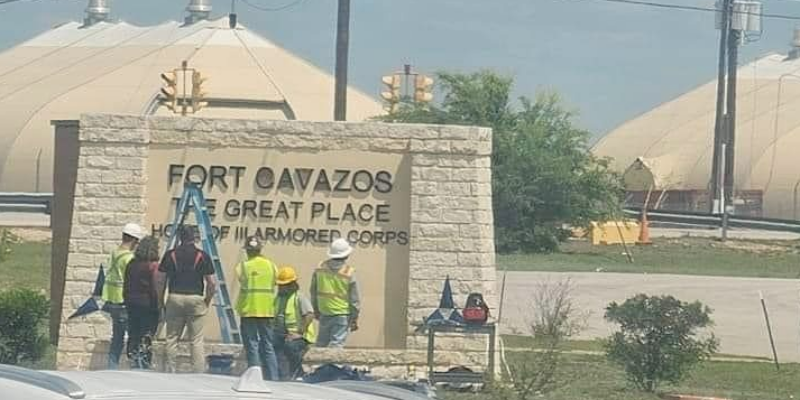The renaming of the Clear Creek gate of America’s largest active-duty armored military base will have to wait a few more weeks.
Social media was abuzz with locals upset about the name change and its related expenses as workers began changing “Fort Hood” to “Fort Cavazos” on one of the main entrances to the base. Later that day the work was mysteriously reversed.
According to the San Antonio Express-News, contractors used a typeface that was not uniform with the rest of the lettering on the sign.
Fort Hood is one of eight or nine bases that are named after Confederate military heroes across the U.S. But after a wave of anti-Confederate sentiment following the George Perry Floyd riots, language was slipped into the National Defense Authorization Act for 2021 to set up a commission to rename those bases plus other memorials to the South. Then-President Donald Trump threatened to veto the NDAA but Congress had the votes to overrrule it.
Formally titled the Commission on the Naming of Items of the Department of Defense that Commemorate the Confederate States of America or Any Person Who Served Voluntarily with the Confederate States of America, the “naming commission” voted to pay homage to a four-star Hispanic Army general, Richard Cavazos, at the recommendation of Defense Secretary Lloyd J. Austin.
Federal officials have until Jan. 1, 2024, to finalize 1,111 name changes under the NDAA.
Fort Hood houses around 40,000 soldiers. It was permanently established in 1950 after a time as Camp Hood. The sprawling base was named after Gen. John Bell Hood, a U.S. and C.S.A. veteran who led the Confederate Army’s Texas brigade at the time of the Civil War. Prior to the War Between the States, Hood saw action in a notable Indian skirmish in Texas while serving with the Fourth U.S. Infantry. Though a native of neutral Kentucky, Hood switched allegiance to the Confederacy when his new state of Texas joined the CSA in 1861. He maintained typical views on race relations of the time and did not favor racial equality or abolition.
Hood had a reputation as being a courageous and aggressive battlefield leader, though his effectiveness as a military leader is debated. At the Battle of Gettysburg, he was severely wounded, rendering his left arm useless for the rest of his life. His loss of his right leg at Chickamauga led to a recuperation period in which he befriended CSA President Jefferson Davis, which no doubt assisted his rise in military rank and as a celebrity of the war.
Advertisement
Despite the physical setbacks, he continued to lead numerous engagements and battles during the rest of the war. Hood surrendered in Natchez, Miss., after the war, and was paroled on May 31, 1865.
While many infantry and lower-ranking military men were pardoned and went on to serve honorably in the U.S. Army in the post-bellum years, during the Plains Wars, and other engagements, officers were typically barred from further service. Hood retired to Louisiana as a cotton and insurance broker, during which time he and his wife became parents to 11 children over 10 years. He died of Yellow Fever in 1879, along with his wife and oldest daughter. Hood’s remaining children were supported financially by the Texas Brigade Association and were adopted by seven families. Hood is buried in Metairie Cemetery in New Orleans.
Whether the new name sticks or not, the base will be named for a military hero. Cavazos gained recognition during the Korean War, when he returned to a raging battlefield five times to retrieve his fellow wounded soldiers. He earned the Distinguished Service Cross, the nation’s second-highest military honor for valor. Following the Korean War, he served as a professor of military science, later leading infantry battalions during the Vietnam War, during which he earned a second service cross.
A native Texan, Cavazos grew up on the storied King Ranch with his family, including brother Lauro Cavazos, a former U.S. Education secretary under Ronald Reagan. He died of Alzheimer’s complications in 2017 and is buried at Fort Sam Houston National Cemetery in San Antonio.
The name change is expected to become official on May 9. While many schools bearing Hood’s name have underwent name changes in recent years, largely rural Hood County in North Texas continues as the most prominent namesake of the general.
Advertisement
Advertisement

